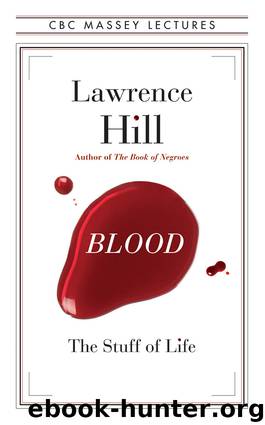Blood by Lawrence Hill

Author:Lawrence Hill
Language: eng
Format: epub
Publisher: House of Anansi Press Inc
Published: 2013-08-08T04:00:00+00:00
IT HAS BEEN IN THE economic interests of government agencies to expand the definition of black identity in order to maximize the economic benefits associated with slave labour, but it was not considered such a valuable idea to define all people with Aboriginal identity as “Indians,” due to the costs associated with providing services to Aboriginal people or recognizing their land rights.
Virginia’s 1924 Racial Integrity Act — one legislative act among many stretching as far back as the 1700s in what would become the United States — referred to blood in defining “colored persons” and “Indians”: “Every person in whom there is ascertainable any Negro blood shall be deemed and taken to be a colored person, and every person not a colored person having one-fourth or more of American Indian blood shall be deemed an American Indian.”
The same act employed what has famously been described as the “Pocahontas exception,” declaring that when the blood was watered down, “Indians” would become white for the purposes of the rules of miscegenation: “It shall hereafter be unlawful for any white person in this State to marry any save a white person, or a person with no other admixture of blood than white and American Indian. For the purpose of this chapter, the term ‘white person’ shall apply only to such person as has no trace whatever of any blood other than Caucasian; but persons who have one-sixteenth or less of the blood of the American Indian and have no other non-Caucasic blood shall be deemed to be white persons . . .” I have cited the Pocahontas exception to establish that, over the course of time, authorities have defined racial groups — limiting or expanding the range of people included — to suit their own needs and whims.
Defining Native Americans by means of blood quantum (the quantity of so-called Indian blood in their veins) has by no means disappeared today. Many writers and scholars have weighed in on this matter. One of them, the American Troy Duster, a sociologist at New York University, notes in an article published in 2006 in the Journal of Law, Medicine and Ethics, “The U.S. Congress passed the Allotment Act of 1887, denying land rights to those Native Americans who were ‘less than half-blood.’ The U.S. Government still requires American Indians to produce ‘Certificates with Degree of Indian Blood’ in order to qualify for a number of entitlements, including being able to have one’s art so identified. The Indian Arts and Crafts Act of 1990 made it a crime to identify oneself as a Native American when selling artwork without federal certification authorizing one to make the legitimate claim that one was, indeed, an authentic (‘one-quarter blood’ even in the 1990s) American Indian.”
The problem with equating authenticity to race is that it attempts to quantify a concept that is inherently absurd. To focus on the authenticity of the blood in our veins is to repudiate deeper realities: we construct and negotiate our own identities as acts of social performance from our first to our last days on the planet.
Download
This site does not store any files on its server. We only index and link to content provided by other sites. Please contact the content providers to delete copyright contents if any and email us, we'll remove relevant links or contents immediately.
Crazy Rich Asians by Kevin Kwan(9147)
How to Bang a Billionaire by Alexis Hall(8057)
Giovanni's Room by James Baldwin(7164)
Little Fires Everywhere by Celeste Ng(7086)
Win Bigly by Scott Adams(7078)
Tease (Temptation Series Book 4) by Ella Frank(5578)
Pachinko by Min Jin Lee(5552)
The Fire Next Time by James Baldwin(5225)
The Perks of Being a Wallflower by Stephen Chbosky(4550)
China Rich Girlfriend by Kwan Kevin(4479)
Bluets by Maggie Nelson(4459)
First Position by Melissa Brayden(4423)
The Sympathizer by Viet Thanh Nguyen(4288)
Rich People Problems by Kevin Kwan(4234)
A Little Life (2015) by Hanya Yanagihara(4150)
Right Here, Right Now by Georgia Beers(4107)
Walking by Henry David Thoreau(3879)
Catherine Anderson - Comanche 03 by Indigo Blue(3550)
The Death of the Heart by Elizabeth Bowen(3531)
